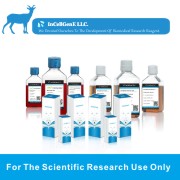

Overview
| Permits and Restrictions | |
|---|---|
| Organism | Homo sapiens, human |
| Tissue | lung; derived from metastatic site: pleural effusion |
| Product Format | frozen |
| Morphology | epithelial |
| Culture Properties | adherent |
| Biosafety Level |
1
Biosafety classification is based on U.S. Public Health Service Guidelines, it is the responsibility of the customer to ensure that their facilities comply with biosafety regulations for their own country. |
| Disease | adenocarcinoma; non-small cell lung cancer |
| Age | 65 years adult |
| Gender | male |
| Ethnicity | Caucasian |
| Storage Conditions | liquid nitrogen vapor phase |
Properties
| Karyotype |
Modal number = 79; range = 71 to 83 This is a hypertriploid human cell line with the modal chromosome number of 79, occurring in 20% of cells. The rate of cells with a higher ploidy was 5.5%. Karyotypes were very complex. There were over 22 marker chromosomes commonly present in most cells, many with complex structural rearrangements. Among these markers were: double copies for t(10qter--10q11.2::?::13C--13qter) and der(9)t(3;9) (p12;p22?), and one copy each for del (1) (p22) and i (iq). There were two normal X chromosomes per cell. Normal chromosomes Y, N1, N5, N14, and N15 were not found. Chromosomes N20 and N22 generally had four or more copies per cell. |
|---|---|
| Clinical Data |
65 years adult
Caucasian
male
|
| HeLa Markers | N |
| Tumorigenic | Yes |
| Effects |
Yes, in nude mice
(Tumors developed within one month in 4/5 nude mice inoculated subcutaneously with 10(7) cells.)
|
| Comments |
An EBV-transformed lymphoblastoid cell line from the same patient is available as ATCC CCL-256.1.
|
Background
| Complete Growth Medium |
HITES medium supplemented with 5% fetal bovine serum
|
|---|---|
| Subculturing |
Volumes used in this protocol are for 75 cm2 flask; proportionally reduce or increase amount of dissociation medium for culture vessels of other sizes.
Subcultivation Ratio: A subcultivation ratio of 1:2 to 1:4 is recommended
Medium Renewal: Every 2 to 3 days
|
| Cryopreservation |
Freeze medium: Complete growth medium supplemented with 5% (v/v) DMSO
Storage temperature: liquid nitrogen vapor phase
|
| Culture Conditions |
Atmosphere: air, 95%; carbon dioxide (CO2), 5%
Temperature: 37��C
|


